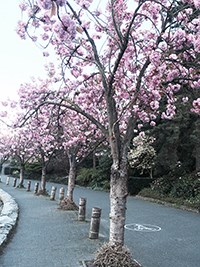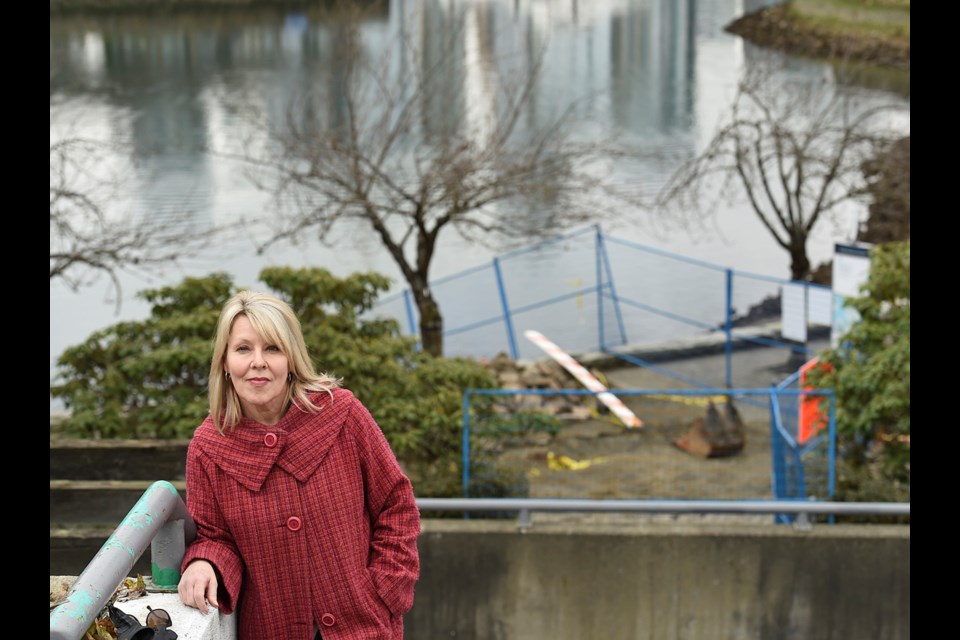A curving line of 17 cherry blossoms that provide a picture-perfect backdrop for people walking or cycling along the South False Creek seawall will soon be no more.
The city is preparing to remove the trees to make room for separated bike and pedestrian paths east of Granville Island to Charleson Park.
The loss of those trees is the “final straw” for Cate Simpson, who walks that stretch of seawall at least once a day.
She posted photos on Facebook of the mature gardens that were recently torn up as part of the same Vancouver Park Board project, sending out an alarm that the trees were about to suffer a similar fate.
“People were in tears when they first opened the gate [around the garden that was destroyed] and saw what they had done,” she told the Courier. “They couldn’t believe their eyes when they saw the level of destruction.”
Now there is fencing along the row of trees. “They put fencing up when chainsaws are coming,” Simpson says.

When contacted by the Courier, a representative of the Park Board sent an email which says, “during the design process, a private certified arborist report was commissioned to determine the feasibility of maintaining the cherries at Alder Bay and at Creekside Drive. The study concluded that the trees were in poor condition due to inferior growing environments. The trees are at the end of their life-spans as they have several health issues including bacterial blights and cherry-bark tortrix.
“Through the seawall upgrades, all of the cherries approved for removal will be replaced and planted in superior conditions with ample soil volumes ensuring water and nutrient availability. On a short time horizon, the new cherry trees will grow to be much healthier and robust than the current specimens.”
Simpson says that while many of the trees are root bound, the signs of distress were evident a long time ago. “The city has chosen to ignore the trees to the point they’re going to tear them down to make room for bike lanes.
“They knew years in advance which trees are going to be distressed. They could have chosen to unbind the roots. Instead they just waited and waited and waited until it was a bigger issue. I’m satisfied they’ll replant the trees. I question whether they had to take them out in the first place. It’s very frustrating.”
Simpson lives on Fairview Slopes and says she is giving voice to the feelings of many people in the neighbourhood, who are already upset that the city cut down mature trees on West 7th Avenue to create a cul de sac west of Oak Street that prohibits through traffic.
She says that while neighbours agree with enhancing bike lanes on the seawall and avoiding conflicts between vehicles, pedestrians and cyclists on the street, they feel the city didn’t consider less drastic options.
“There was a consultation process” — the park board posted recommendations on the South False Creek Seawall park upgrades and tree replacement in April 2016 — “if you searched hard enough,” she said. “If you dig deep there were opportunities for people to share their opinions. But you had to be someone on the seawall to know it was happening; you weren’t given the opportunity to be involved in decisions that had already been made. The consultation process was that the city sent notices to bike groups but not the neighbourhood. They are asking for people who are issue-based to influence what goes on in our neighbourhood. We find it insulting that rather than truly listen to people in the neighbourhood who have other options they bring in outside advocacy groups.”
The park board had a 12-member focus group which included a representative of the False Creek Residents Association but Simpson says the process should have been more open to the community.
Last summer she says the city put up a tent on the seawall and staffed it with people to talk about the project and gather opinions. “I stood around and heard a lot of suggestions including using the rail line [that runs from Granville Island to Science World] or the road that runs behind Charleson Park as a commuter bike path. They were never later presented as options. We all asked to be put on a mailing list for consultations. We’re not on the list.”
Simpson says the only letter she’s received is one that arrived on Wednesday about the future of leases and future planning work in the False Creek South neighbourhood, where 60 per cent of the land is owned by the city.
At present, that stretch of seawall has shared lanes for cyclists and pedestrians going in either direction. The project includes creating a dedicated bike lane which will have an asphalt surface. “It’s just such a shame that at the end of the day it seems we’re going to get black asphalt which is ugly and an eyesore. It’s paving over paradise to put in a bike lane.”
Simpson agrees the seawall can be congested in the summer but says the project won’t make the path safer for recreational cyclists and families with young children. Cyclists who use the seawall to commute often travel at a faster rate of speed, which is why she says the people she talked to suggested a commuter bike lane behind the park and residential buildings.
“We have an aging population that’s not considered, pedestrians who feel they’re not a priority and [the sense that] beautiful mature gardens are less important than bike infrastructure.”
When it came to assessing bike traffic on West 7th, she says city officials told her that numbers are based on a sunny day during the August civic weekend in order to capture maximum use. “Surely you’d want to capture the usual use,” she counters. “It felt manipulated.”
Neighbourhood suggestions to improve safety included bike-friendly speed bumps.
She feels that consultation with people in the neighbourhood was not only lacking but that the process was skewed in favour of cyclists.
“It was the wrong type of consultation. They cherry picked what they consulted about. A lot of people weren’t aware that it was actually going to happen,” she says. Signs in the neighbourhood were “misleading” and didn’t ask for feedback. When residents were asked for their opinion about how to rectify traffic issues on West 7th, they were presented with three options that had already been decided on. “It was Bad, Worse and More Worse. You were forced to agree with the one that was the least distasteful.”



